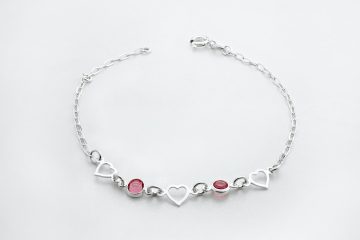Bracelets are beautiful accessories that can add a touch of elegance and style to any outfit. However, one of the most frustrating aspects of wearing bracelets is struggling to clasp them properly. Whether you are a beginner or someone who has always struggled with clasping bracelets, fear not! In this step-by-step guide, we will walk you through the process of mastering the art of bracelet clasping. From choosing the right type of clasp to understanding different techniques, we’ve got you covered.
1. Understanding Bracelet Clasps
Before we dive into the various techniques, it is important to understand the different types of bracelet clasps available. There are several common clasps used for bracelets, including lobster clasps, toggle clasps, spring ring clasps, and magnetic clasps. Each type has its own unique mechanism and requires a specific technique for proper clasping.
2. Choosing the Right Clasp
When selecting a bracelet, it is essential to consider the type of clasp that would work best for you. Lobster clasps are secure and easy to use, making them a popular choice. Toggle clasps add a decorative element and are ideal for bracelets with larger links. Spring ring clasps are small and discreet, making them perfect for delicate bracelets. Magnetic clasps offer convenience and are suitable for people with limited dexterity. By choosing the right clasp, you can ensure a comfortable and hassle-free wearing experience.
3. Preparing Your Bracelet
Before attempting to clasp your bracelet, it is important to prepare it properly. Lay the bracelet flat on a clean surface to avoid tangling. If the bracelet has a charm or pendant, make sure it is facing the right way and is centered. Taking a moment to prepare your bracelet will save you time and frustration when it comes to clasping it.
4. Technique 1: Lobster Clasp
The lobster clasp is one of the most common types of clasps used in bracelets. To clasp a bracelet with a lobster clasp, hold one end of the bracelet in your dominant hand and the other end in your non-dominant hand. Insert the small ring or jump ring attached to the lobster clasp into the larger ring at the other end of the bracelet. Once inserted, use your dominant hand to push the lever of the clasp down until it clicks into place. Ensure that the clasp is securely fastened by giving the bracelet a gentle tug.
5. Technique 2: Toggle Clasp
Toggle clasps consist of a T-shaped bar and a circular or oval loop. To clasp a bracelet with a toggle clasp, hold the bracelet in one hand and the bar in the other. Insert the bar through the loop, ensuring that it is fully inserted. The weight of the bracelet will help keep the clasp in place. Toggle clasps can be a bit tricky at first, but with practice, you will become more adept at fastening them.
6. Technique 3: Spring Ring Clasp
Spring ring clasps are commonly used in delicate bracelets. To clasp a bracelet with a spring ring clasp, hold one end of the bracelet in your dominant hand and the other end in your non-dominant hand. Insert the small ring attached to the clasp into the larger ring at the other end of the bracelet. Once inserted, use your dominant hand to push the lever of the clasp down until it clicks into place. Give the bracelet a gentle tug to ensure that the clasp is securely fastened.
7. Technique 4: Magnetic Clasp
Magnetic clasps are ideal for those who struggle with traditional clasps due to limited dexterity. To clasp a bracelet with a magnetic clasp, bring the two ends of the bracelet close together. The magnets will attract each other, ensuring a secure closure. It is important to note that magnetic clasps may not be suitable for everyone, especially those with pacemakers or other medical devices that can be affected by magnets.
8. Troubleshooting Common Issues
Sometimes, even with the right technique, you may encounter difficulties when clasping your bracelet. Here are a few troubleshooting tips to help you overcome common issues:
– If the clasp keeps slipping out of your hand, try using a small piece of cloth or tissue for better grip.
– For bracelets with small clasps, use a pair of tweezers to hold the clasp while you insert it into the ring.
– If the bracelet is too tight to clasp comfortably, consider using a bracelet buddy or asking someone for assistance.
9. Practice Makes Perfect
Like any skill, mastering the art of bracelet clasping requires practice. Don’t get discouraged if you don’t succeed on your first attempt. Keep practicing and experimenting with different techniques until you find what works best for you. Over time, you will become more confident and efficient in clasping your bracelets.
Conclusion
Clasping a bracelet doesn’t have to be a frustrating experience. By understanding the different types of clasps, choosing the right clasp for your bracelet, and practicing different techniques, you can master the art of bracelet clasping. Remember to take your time, prepare your bracelet properly, and troubleshoot any issues that may arise. With patience and perseverance, you’ll soon be effortlessly clasping your bracelets and enjoying the added beauty they bring to your outfits.
FAQs
1. How do I choose the right size bracelet for my wrist?
When selecting a bracelet, measure your wrist circumference and add half an inch to an inch for a comfortable fit. If you prefer a looser fit, add a bit more. Remember to consider the size of the clasp when choosing the appropriate length.
2. Can I modify the clasp of a bracelet if I find it difficult to use?
In some cases, it may be possible to replace the clasp of a bracelet with a different type that is easier for you to use. Consult a jeweler or a professional bracelet maker for advice and assistance.
3. How do I clean my bracelets without damaging the clasps?
To clean your bracelets, use a soft cloth or a jewelry cleaning solution that is safe for the materials of your bracelet. Avoid soaking the clasps in water or using harsh chemicals that can corrode or damage the clasp.
4. What should I do if the clasp of my bracelet breaks?
If the clasp of your bracelet breaks, take it to a professional jeweler for repair. They will be able to assess the damage and either fix the clasp or suggest a suitable replacement.
5. Can I wear bracelets with different types of clasps together?
Yes, you can mix and match bracelets with different types of clasps. However, be mindful of the overall look and balance of the bracelets when layering them. Experiment with different combinations to create a stylish and cohesive look.




